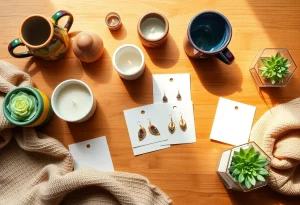Table of Contents
Understanding the Etsy Marketplace
Etsy has grown into a bustling online marketplace for unique, handmade, and vintage items. With over 96 million active buyers and 7.5 million active sellers as of 2023, it’s a goldmine for creative entrepreneurs. But standing out in this sea of sellers can be tricky.
New Etsy shops often face a waiting game before that exciting first sale. While some lucky sellers might see a purchase within days, others might wait weeks or even months. The average timeline? About 2-4 weeks for most newbies.
Common Hurdles for New Etsy Sellers
- Getting noticed among millions of listings
- Figuring out the right pricing strategy
- Mastering Etsy’s search algorithm
- Building a brand that stands out
- Managing inventory and shipping
Let’s look at some key Etsy stats:
| Metric | Value |
|---|---|
| Average order value | $46 |
| Top-selling category | Home & Living |
| Etsy’s global market share | 2.9% |
Understanding these numbers can help you set realistic goals and find your niche.
Want to see how quickly you can make your first sale? Check out this video for some quick tips:
While Etsy offers a huge opportunity, managing multiple sales channels can get overwhelming. That’s where tools like Marketplace Connect come in handy, helping you keep track of orders and inventory across different platforms.
Remember, success on Etsy isn’t just about making that first sale. It’s about building a sustainable business that keeps customers coming back. Let’s dive into some strategies to help you do just that.
Craft Irresistible Product Listings
Getting those first Etsy sales can feel like climbing a mountain. But with the right approach, you’ll be ringing up orders in no time. Let’s start with the foundation – your product listings.
The key is to make your items impossible to scroll past. Eye-catching titles are your first hook. Use descriptive words that paint a picture and include relevant keywords. For example, “Handmade Boho Macramé Plant Hanger” tells shoppers exactly what you’re offering.
- Keep titles under 140 characters
- Front-load important keywords
- Avoid excessive punctuation or all caps
Next up: product descriptions that sell. Focus on benefits, not just features. Instead of “100% cotton shirt,” try “Stay cool and comfortable all day in this breathable cotton tee.” Remember, you’re not just selling a product – you’re selling an experience.
Don’t skimp on product photos. Clear, well-lit images from multiple angles are non-negotiable. Consider lifestyle shots that show your item in use. A picture really is worth a thousand words (and potentially a sale).
Pricing can be tricky for new sellers. Research similar items, factor in your costs and time, then price competitively. Don’t undersell yourself, but consider offering an introductory discount to attract those crucial first customers.
This video dives deeper into strategies for nailing those first 100 sales. It’s packed with actionable tips you can start using today.
Master Etsy SEO for Visibility
You’ve got great products, but if no one can find them, you won’t make sales. That’s where Etsy SEO comes in. It’s not as complicated as it sounds, promise.
- Understand Etsy’s search algorithm
- Do keyword research in your niche
- Optimize your shop sections and About page
- Use long-tail keywords in listings
- Keep your shop fresh with regular updates
Etsy’s search algorithm looks at things like listing quality, customer experience, and how well your tags match what shoppers are searching for. Speaking of tags, use all 13 available and make them count. Think like a buyer – what words would you use to search for your product?
Long-tail keywords are your secret weapon. Instead of just “necklace,” try “handmade silver moon pendant necklace.” It’s more specific and likely to match what your ideal customer is looking for.
- Use relevant attributes for your listings
- Update your shop regularly with new items or renewed listings
- Encourage reviews to boost your shop’s credibility
Remember, SEO isn’t a one-and-done deal. It’s an ongoing process. Keep tweaking and testing to see what works best for your shop.
Promote Your Shop Beyond Etsy
Etsy’s a great platform, but don’t put all your eggs in one basket. Spreading the word about your shop across different channels can supercharge your sales.
| Platform | Best For | Content Type |
|---|---|---|
| Visual products | Product pins, infographics | |
| Behind-the-scenes, lifestyle | Photos, Stories, Reels | |
| TikTok | Trending, viral potential | Short videos, challenges |
Social media is your friend. Share your products, but also give followers a peek behind the curtain. Show your process, share your inspiration, or give styling tips. It’s about building a connection, not just pushing sales.
Email marketing is often overlooked by new Etsy sellers, but it’s a powerful tool. Offer a small discount or freebie in exchange for email signups. Then, keep in touch with updates, new product launches, and exclusive offers.
Don’t forget about the power of community. Join online forums or Facebook groups related to your niche. Share your expertise, not just your products. Building genuine connections can lead to loyal customers and valuable word-of-mouth marketing.
Etsy ads and offsite advertising can give your shop a boost, but use them strategically. Start small, track your results, and adjust as needed. And remember, while paid advertising can help, it’s not a substitute for organic growth strategies.
Managing multiple sales channels can get tricky as your business grows. That’s where tools like Marketplace Connect come in handy. It helps streamline order management and inventory updates across different platforms, saving you time and headaches.
Remember, success on Etsy doesn’t happen overnight. Stay patient, keep refining your approach, and don’t be afraid to try new things. With persistence and the right strategies, those sales will start rolling in.
Measuring Success and Iterating
Getting your first Etsy sales is exciting, but the real challenge lies in maintaining and growing that momentum. Smart sellers know that success on Etsy isn’t just about making sales – it’s about understanding what drives those sales and continuously improving your approach.
Let’s break down the key metrics you should be watching like a hawk:
- Views and visits
- Conversion rate
- Average order value
- Revenue per listing
- Customer acquisition cost
Etsy Analytics is your best friend here. It’s packed with data that can inform your decision-making. But don’t just collect numbers – use them to tell a story about your shop’s performance.
One powerful strategy for boosting sales is A/B testing. Here’s a simple process to get you started:
- Choose one element to test (e.g. product photos, titles, pricing)
- Create two versions
- Run both versions for a set time period
- Compare results
- Implement the winner and repeat
Remember, customer feedback is gold. Reviews aren’t just for show – they’re a direct line to understanding what your buyers love (or don’t) about your products. Use this insight to refine your offerings and marketing approach.
Managing all these moving parts can be overwhelming, especially as your shop grows. That’s where tools like Marketplace Connect come in handy, helping you keep track of inventory and orders across multiple channels without breaking a sweat.
The key to Etsy success is staying nimble. Keep testing, keep learning, and don’t be afraid to pivot when the data points you in a new direction. Your first sales are just the beginning of your Etsy journey.
Wrap-up
Getting those first Etsy sales can feel like a tough climb, but it’s totally doable with the right approach. Remember, great photos, solid SEO, and competitive pricing are your best friends. Don’t forget to engage with your customers and keep tweaking your shop based on what works.
Persistence is key. You might not see results overnight, but stick with it. Keep learning, adjusting, and improving your offerings. As your shop grows, you’ll want to streamline your processes. That’s where tools like Marketplace Connect come in handy, helping manage orders across different platforms without the headache.
Ready to put these tips into action? Start small, be patient, and watch your Etsy shop bloom. Who knows? Your side hustle today could become your main gig tomorrow. Got more questions? Check out our FAQ section below for quick answers to common Etsy selling concerns.
Common Questions from New Etsy Sellers
How long does it typically take to make a first sale on Etsy?
There’s no set timeline for your first Etsy sale. Some sellers see results within days, while others may wait weeks or months. Focus on creating quality listings, using relevant tags, and promoting your shop. Consistency and patience are key.
Should I offer free shipping to boost initial sales?
Free shipping can attract buyers, but it’s not always necessary. Consider building shipping costs into your product prices or offering free shipping on orders over a certain amount. Test different approaches to see what works best for your shop and profit margins.
How many listings should I have when starting out on Etsy?
Start with at least 10-20 quality listings to give your shop a professional look. This provides enough variety for shoppers and increases your chances of being found in search results. As you grow, aim to add new listings regularly.
Is it worth investing in Etsy ads as a new seller?
Etsy ads can boost visibility, but they’re not always necessary for new sellers. Focus first on optimizing your listings and tags. Once you have some sales and understand your profit margins, you can experiment with a small ad budget to see if it drives more traffic and sales.
How can I make my Etsy shop stand out from competitors?
Stand out by offering unique products, providing excellent customer service, and creating a cohesive brand identity. Use high-quality photos, write detailed descriptions, and engage with your customers. Consider using tools like Marketplace Connect to streamline your operations and focus on growing your business. Our app can help you manage orders across multiple platforms efficiently.
How often should I update my Etsy listings?
Regularly refreshing your listings can improve your search ranking and keep your shop looking current. Aim to update titles, tags, or photos every few weeks. For seasonal items, plan updates well in advance. Using inventory management tools can help you keep track of these changes across all your sales channels.





